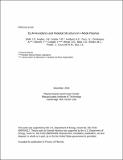Edge-localized mode avoidance and pedestal structure in I-mode plasmas
Author(s)
White, A. E.; Theiler, C.; Churchill, Randy Michael; Snyder, P. B.; Osborne, Thomas H.; Dominguez, A.; Cziegler, Istvan; Walk Jr, John R.; Hughes, Jerry W., Jr.; Hubbard, Amanda E.; Terry, James L.; Whyte, Dennis G.; Baek, Seung Gyou; Reinke, Matthew Logan; Rice, John E.; ... Show more Show less
DownloadWhite_Edge-localized.pdf (1.268Mb)
OPEN_ACCESS_POLICY
Open Access Policy
Creative Commons Attribution-Noncommercial-Share Alike
Terms of use
Metadata
Show full item recordAbstract
I-mode is a high-performance tokamak regime characterized by the formation of a temperature pedestal and enhanced energy confinement, without an accompanying density pedestal or drop in particle and impurity transport. I-mode operation appears to have naturally occurring suppression of large Edge-Localized Modes (ELMs) in addition to its highly favorable scalings of pedestal structure and overall performance. Extensive study of the ELMy H-mode has led to the development of the EPED model, which utilizes calculations of coupled peeling-ballooning MHD modes and kinetic-ballooning mode (KBM) stability limits to predict the pedestal structure preceding an ELM crash. We apply similar tools to the structure and ELM stability of I-mode pedestals. Analysis of I-mode discharges prepared with high-resolution pedestal data from the most recent C-Mod campaign reveals favorable pedestal scalings for extrapolation to large machines—pedestal temperature scales strongly with power per particle P[subscript net] [over [bar over n][subscript e]], and likewise pedestal pressure scales as the net heating power (consistent with weak degradation of confinement with heating power). Matched discharges in current, field, and shaping demonstrate the decoupling of energy and particle transport in I-mode, increasing fueling to span nearly a factor of two in density while maintaining matched temperature pedestals with consistent levels of P[subscript net] [over [bar over n][subscript e]]. This is consistent with targets for increased performance in I-mode, elevating pedestal β [subscript p] and global performance with matched increases in density and heating power. MHD calculations using the ELITE code indicate that I-mode pedestals are strongly stable to edge peeling-ballooning instabilities. Likewise, numerical modeling of the KBM turbulence onset, as well as scalings of the pedestal width with poloidal beta, indicates that I-mode pedestals are not limited by KBM turbulence—both features identified with the trigger for large ELMs, consistent with the observed suppression of large ELMs in I-mode.
Date issued
2014-04Department
Massachusetts Institute of Technology. Plasma Science and Fusion CenterJournal
Physics of Plasmas
Publisher
American Institute of Physics (AIP)
Citation
Walk, J. R., J. W. Hughes, A. E. Hubbard, J. L. Terry, D. G. Whyte, A. E. White, S. G. Baek, et al. “Edge-Localized Mode Avoidance and Pedestal Structure in I-Mode Plasmas.” Phys. Plasmas 21, no. 5 (May 2014): 056103.
Version: Original manuscript
ISSN
1070-664X
1089-7674